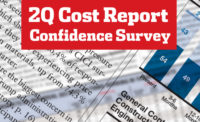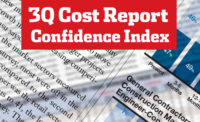
The industry is now in a period of steady growth. While many firms are disappointed the recovery from the recession was not faster, most believe the current growth rate will continue at least through the beginning of 2016. But with the growth on the top line, many firms worry about the bottom line.
The ENR Construction Industry Confidence Index survey for the third quarter shows that, of the 357 executives of large construction and design firms responding to the survey, the vast majority believe the market is stable or growing. The CICI index inched up another point, to a record 77 on a scale of 100, in the third-quarter survey, an indicator of a growth market.
The CICI measures executive sentiment about the current market and reflects the respondents' views on where it will be in the next three to six months and over a 12- to 18-month period. The index is based on responses to surveys sent out to more than 6,000 U.S. firms on ENR's lists of leading contractors, subcontractors and design firms. The latest results are based on a survey conducted from Sept. 4-22.
For the sixth-straight quarter, the surveyed industry executives believe all the market sectors measured by the CICI are now in growth mode. The index has risen steadily as the percentage of firms believing that the market continues to decline has shrunk to single digits.
While survey respondents generally believe the overall market will continue to pick up steam over the next 18 months, many believe the market will begin to level off in three years. This quarter, 58% say the current market is growing. When asked their opinion on what the market will look like in three years' time, only 45% of the execs polled thought the market would still be growing.
For the CICI survey, execs were asked to assess current and future market prospects in general and in any of 15 market sectors in which they currently work. Among the individual market sectors, the petroleum market ranked as the highest-rated for the fifth-straight quarter, with a CICI rating of 79.
The second-highest-rated market, multi-unit residential, is showing surprising strength at 75, up one point from the second quarter. Many execs believe this robust market will begin to falter in the next year to 18 months.
Confidence in the infrastructure markets rebounded in this quarter. Transportation was up four points, to 64, and the water-and-sewer sector rose six points, to 66. Several execs said government funding of infrastructure will become more stable and begin to rise after the November elections.
CFOs Worry About Bottom Line
The soon-to-be-released results of the latest Confindex survey from the Construction Financial Management Association, Princeton, N.J., shows growing concerns about contractors' business fundamentals. CFMA polls 200 CFOs from general contractors, subcontractors and civil contractors.
While a Confindex rating of 100 indicates a stable market, higher ratings show growth is expected. "Our Confindex fell by two points, to 127 [on a scale of 200], for the third quarter," says Stuart Binstock, CEO of CFMA.
Binstock notes that the "overall business conditions" and the "year-ahead outlook" components of the CFMA survey fell the most, dropping six points each, to 143 and 130, respectively. "Part of the drop in the Confindex is that the recovery from the recession has not been as robust as our members anticipated," he says.
The drop in confidence in the CFMA Confindex contrasts with the growing confidence in ENR's CICI index. However, part of the reason for the divergence is that the indices look at the market from slightly different perspectives.
"The overall market has been growing, raising the top line. However, our members are becoming increasingly worried about the issues that come with a growing market: inflation and skills shortages, which raise operating costs that directly affect the bottom line," says Anirban Basu, CEO of economic consultant Sage Policy Group Inc., Baltimore, and CFMA economic adviser.
Binstock points out how the prospects of rising costs are being perceived by Confindex survey participants, saying, "The number of our members that are concerned about the shortage of skilled workers rose from 62% in the last quarter to 72% in this quarter. So, CFOs clearly are worried about labor costs down the line."
Basu says larger construction firms are better equipped to cope with worker shortages. Firms increasingly are turning to technology and processes that promote efficiency to make up for a shrinking applicant pool, Basu says. "The problem is that technology and training are expensive, and the big firms are better able to absorb the initial outlays that technology demands," he observes.
The CICI survey also asked if firms' access to working capital has changed in the past six months: 24.5% said financial institutions have been more open to lending for operating capital, and only 5.8% said they were tougher.
Financial institutions also continue to provide project financing. In this quarter, 39.7% of CICI respondents said credit for project financing was easier to obtain than six months ago, up from 33.9% last quarter. However, only 4.9% said they saw any tightening in project financing.




Post a comment to this article
Report Abusive Comment